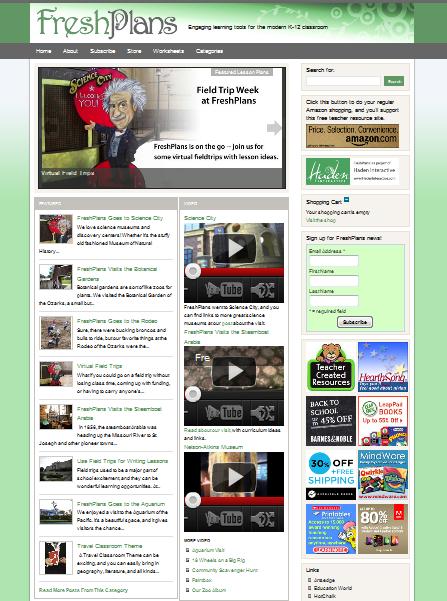Your cart is currently empty!

Lab Report: Ad Performance
We’ve been playing around with ads at our lab site, FreshPlans. People ask us about monetizing sites sometimes; we write for successfully monetized sites, but the process of getting from website to monetized website is fraught with peril — or at least most people don’t seem to succeed at it. We wrote about the basic overview of how people make money online in How Do You Get Paid? but we also want to share some specific data from our ad experiments.
The first thing to acknowledge about making money with ads, whether they are affiliate ads, pay per click, or paid banners on your website, is that traffic is the name of the game. People decide whether and what to pay for ad space based on traffic, and most ad programs have minimum traffic requirements.
If you have fewer than 10,000 pageviews a month at your website, you should be concentrating on traffic and increasing content — you’re not ready to monetize. Once you reach that threshold, you can sell ads for about $50 a month. Hit 10,000 a day and you can charge premium prices.
Enough with common knowledge: let me show you some numbers.
At FreshPlans, Amazon is the actual moneymaker (though still a modest moneymaker). At the beginning of July, we added a block of 125 x 125 ads in the right hand sidebar (the part people ignore because it’s full of ads). This gives us six weeks of data, with 55,733 pageviews, and we know from our sales at Amazon that our visitors are in the mood to shop. We figure this means that we can feel fairly confident that our data is meaningful.
We have eight ad blocks, for eight different companies. We made a couple of changes in the first weeks, dropping two companies that got no response and adding two that we felt might be more promising. We’re not being aggressive about our ads, as you can see in the screenshot above — the block of ads is well below the fold. On average, we’re seeing one click through for every 800 impressions.
However, there’s a wide range within that average. Here you can see the click through stats for our least successful group:
Were we doing pay per click, it is clear that we’d be much happier with Chronicle Books than with LeapFrog, for example. In this case, we’re being paid for sales — and you can see that if we were out to make money, we wouldn’t be happy with any of them.
Can I also take just a moment to point out that buying ad space on the basis of impressions isn’t always a good deal? We’ve been offered ad space before with promises of 70,000 impressions a year as though that were a good thing. That particular offer boasted a .05- .3 click through rate, which you can see is pretty typical according to our experience. If you have nothing to compare it with, you can be much more impressed by those numbers than you should be.
Our most successful company (aside from Amazon) is the one for which we made both a 125 x 125 block ad and text links to the catalog. You can see from the chart below that the block has a better click through rate than any of the ads in the chart above except Chronicle Books. The text links have by far the best click through rate. They’ve made over twice as many sales as the block, too — but look at the commissions. Each click on the block ad has been worth $25.17 in sales to the advertiser. Each click on a text link has brought them a mere $1.85. We’re not coining money with either one, but it’s obvious that the advertiser would be better off doing a pay per click arrangement with a banner ad than with a text link.
I should also mention that we’ve seen serious increases in the sales of TCR products at Amazon, and slight increases in the sales of Chronicle Books. Some of the clicks through to other publishers appear to be heading back to our website and doing their shopping at Amazon instead. Free shipping is huge.
Our little lab site is just over a year old, and we’re currently getting about 1,000 visits per day. We haven’t seen any negative consequences (complaints, drops in traffic, etc.) from having those ads up. The takeaway, if you want to monetize your site:
- It’s all about the traffic. Maybe I already said that. Traffic isn’t necessarily the most important metric for business sites, but for ads it is. Focusing on increasing traffic will probably always be the best use of your time, compared to messing around with your ads.
- Watch your stats. Some companies will convert better than others. Be aware of seasonal variations, though — toy companies might do more for us during the holidays. If you’ve already spent time working on traffic, you can put some effort into making sure your ads are well targeted for your population.
- Mix text and banner ads. While text ads definitely have a better click through rate (we felt that people completely ignored them when we experimented with them early on using Amazon only), banner ads may have better sales. We don’t have enough data to say this with certainty, but there does seem to be some sense to it. Someone who clicks through the block ad may be thinking, “Oh, good — I’ve been needing something from them,” where clicks through text links may be more often out of curiosity.
We haven’t decided whether to remove the ads after our experiment, or to leave just a few. Ad blindness (the OPA doesn’t believe in it, but most of us do) means that people don’t click on ads much, but it also means that they don’t object to them much.



Leave a Reply